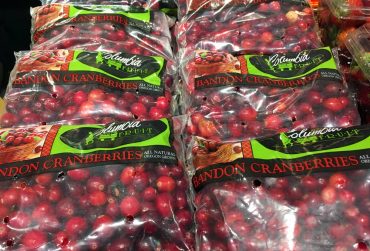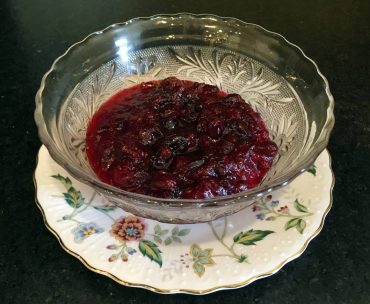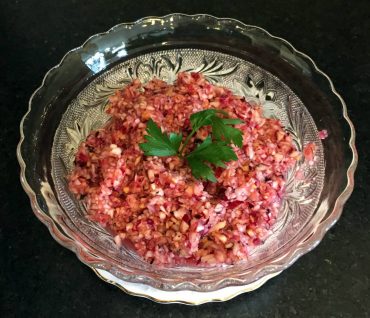
Cranberries have been a staple on Thanksgiving tables in the United States since the Pilgrims first feasted with the Wampanoag in 1621. The native populations had been using the wild cranberry Vaccinium macrocarpos throughout their history. It is believed they used the fruit for medicinal as well as nutritional purposes.
The early peoples made pemmican — cranberries Mixed with nuts, seeds and meat from deer and dried into a cake. Naturally preserved and portable, pemmican was undoubtedly the first protein bar.
Cranberry gets its English name from “crane-berry” because many thought the stem and blossom resembled a crane’s head. The plant’s closely related cousin, Vaccinium oxycoccus, occurs naturally over widespread areas of North America, Northern Europe and Asia.
It prefers boggy soils low in nitrogen, hence the best growing areas in the United States are those along the northern coasts. The native North American variety produces a larger, firmer berry.
In about 1817, Capt. Henry Hall in Dennis, Massachusetts, noticed that cranberries grew better when sand blew over them. He began to experiment with various techniques of cultivation in order to increase yields and predictability of harvest.
He was accused of “tinkering with the vines,” according to www.cranberries.org, but his hard work paid off and eventually the commercial cranberry industry was born. Until the late 1930s, all cranberries were sold fresh for use at Thanksgiving and Christmas. Industry development and aggressive marketing of the fruit helped to find innovative ways to use it, and a plethora of new products was born.
Today, only a tiny percentage of the crop is sold fresh. Most berries are crushed for juice, from which canned, jellied sauce is made. Dried cranberries have found their way into home pantries as a favored addition to baked goods, salads and main dishes.
Washington state produces about 0.025 percent of the national yield, and about 99 percent of those berries are marketed through the Ocean Spray cooperative. Within the past 40 years, the evidence of fresh cranberries in grocery stores has changed from large bulk bins and two or three brands of fresh one-pound bags of berries, to just a few 12-ounce bags of one brand, usually under the major Ocean Spray label.
Oregon has a thriving cranberry industry, the area around Bandon in its center. The annual three-day Cranberry Festival takes place the second weekend in September and features a parade, a special cranberry market and open tours at local bogs, among many other family-friendly activities.
In Ilwaco, Washington, the Columbia Pacific Heritage Museum sponsors a Cranberrian Fair in conjunction with other cranberry festival activities during the second weekend of October each year.
In recent years, a new generation of young farmers are trying their hand at raising organic cranberries. One such couple, Jessica Tantisook and her partner, Jared Oakes, farming near Long Beach, received their organic certification in 2013.
In the Bandon, Oregon area, Scott Riddle, a third-generation farmer, began his organic cranberry operation in 1995. He now farms 5 acres of organic berries.
Freshly prepared cranberry sauce has a much fresher taste than the stuff in cans. Two versions are popular, cooked whole berry sauce and freshly ground raw relish. For a southwestern flair, make a salsa of the raw version by adding a few diced, pickled jalapeño peppers.
The tartness of this ancient fruit enhances the flavor of any roasted meat or game, in addition to adding freshness to sandwiches, wraps and cheese canapés. Eat the jalapeno version with chips or in a taco.

Homemade Cranberry Sauce
Ingredients:
- 1 12 oz package of fresh cranberries
- 1 cup sugar
- Juice of 1 large orange
- 2 tbsp orange zest
Instructions:
Empty berries into a colander and rinse thoroughly, picking out any soft or spoiled berries.
Grate zest from the orange and set aside.
Juice orange and place juice with sugar in a heavy saucepan. Stir over medium heat until sugar is dissolved.
Add berries and continue to heat, stirring occasionally until the berries have given up their juice and all berries have burst.
Remove from heat, stir in orange zest and place in bowl to cool.
Note: Cinnamon or other spices may be added and cooked with the berries if desired.

Fresh Cranberry Relish
Ingredients:
- 1 small red onion
- 1 small orange
- 1 small apple
- 1 12 oz bag cranberries, rinsed
- 1 tbsp sugar
- 2 tsp lime juice
- 1 tbsp cider vinegar
- 1/2 tsp salt
- A few grinds of fresh pepper
Instructions:
Peel and quarter onion. Quarter and seed apple (no need to peel). Quarter orange (no need to peel).
Place all above in food processor, pulse to very coarsely chop. Add cranberries, sugar, lime juice, vinegar, salt and pepper. Pulse until contents a coarse “relish” consistency.
Adjust seasonings to taste.
Note: If using pickled jalapeños, add with the cranberries.




























Comments